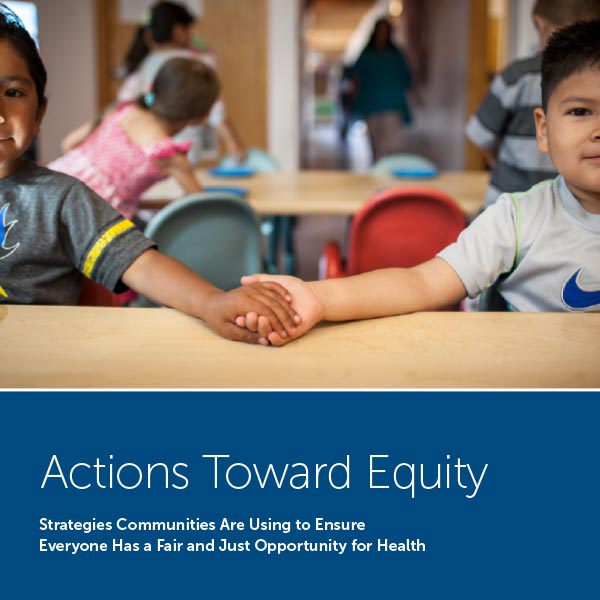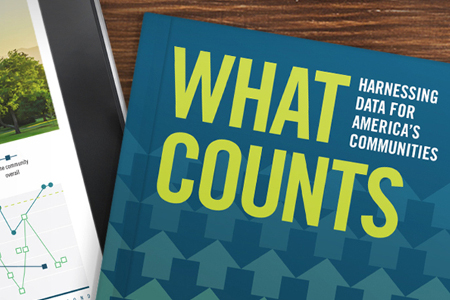
…In 2015, Communities Joined in Action (CJA) launched this take-home advice series to accelerate local organizations’ efforts toward achieving better health and well-being for their communities. This marks the sixth issue in this series, which is based on semiannual surveys of leaders from organizations catalyzing population health in order to provide usable information for communities. This installment is…

…When you invest in the Enterprise Community Impact Note, you are supporting the creation of vibrant and equitable communities where families have access to healthy, affordable homes connected to good schools, jobs, transit and health care services. This report features the stories of people who are prospering thanks to your support. They are residents and patients at CAMBA Gardens in…

…social and economic factors, maximize existing assets, build partnerships, and engage residents to improve health for everyone. All Prize-winning communities are working to advance equity in multiple ways across the six Prize criteria (see box below). This analysis of Prize winners’ application materials, conducted by the University of Wisconsin Population Health Institute, specifically examines two areas considered crucial to advancing health…

…A new book, What It’s Worth: Strengthening the Financial Future of Families, Communities and the Nation provides a 360-degree view of the financial problems and challenges millions of American households face. The book highlights the enormous creativity and innovation underway to improve financial well-being, and provides concrete ways that nearly all sectors of society can implement proven and…

… The potential of community-based solutions to advance health equity is a focus because the Robert Wood Johnson Foundation (RWJF) asked the Committee on Community-Based Solutions to Promote Health Equity to consider solutions that could be identified, developed, and implemented at the local or community level. However, the report focus should not be interpreted to suggest that community-based…

…Developed by the University of Illinois Chicago’s Nathalie P. Voorhees Center for Neighborhood and Community Improvement this toolkit presents strategies for addressing the pressures of gentrification in a community during different phases of gentrification….

…Community development isn’t just about where low-income people live; it’s about how well they live. Zip code and health are intrinsically linked. In the first of a series of articles on this from the Institute for Comprehensive Community Development, LISC’s Amy Gillman looks at how and why community development has become so critical to the question of better health…

…An increasing number of initiatives have been launched with a goal of inspiring multisector approaches to improving community health. Public health agencies at local, state, and federal levels, in partnership with other government leadership, can play a vital role in leading across silos and bringing the various sectors together. The broad, community efforts for public health exemplified by…

…This resource is a side by side comparison of the regulatory structures and policy goals of the Community Reinvestment Act and Non-Profit Hospital Community Benefit. This comparison was produced in partnership between the National Alliance of Community Economic Development Associations (NACEDA) and Community Catalyst….

…how blight affects the health of individuals and neighborhoods while offering a blend of policy and program recommendations to help guide communities in taking a more holistic and coordinated approach, such as expanding the use of health impact assessments, tracking health outcomes, and infusing public health into housing policies, codes and practices. By Erwin de Leon and Joseph Schilling…

…This report by the New York State Health Foundation outlines which hospitals in New York State and nationally are addressing non-medical determinants of community population health, as well as facilitators of and barriers to this work. …

…“Community investing” is investment that seeks to deliver social benefits to low-income or marginalized communities while also generating a financial return. This report provides an overview of the U.S. Community Investing (USCI) field: the types of intermediary organizations raising investments and deploying them in underserved communities, the range of investment products that are available, and the types of investors…

…David Erickson of the Federal Reserve Bank of San Francisco discusses how the RWJF Commission to Build a Healthier America can help bridge the gap between health and community development. Erickson builds on the RWJF Commission’s initial recommendations to show how community development can improve health, calling for the merging of two key approaches—ameliorating the social determinants of health,…

…Over the past four decades, the Healthy Communities movement has transformed traditional definitions and approaches to health. Philanthropic organizations, nonprofits, and government agencies—driven by the disconnect between health spending and health outcomes, the growing awareness of the importance of the social determinants of health, and the need to address poverty as a means of improving health—are leading efforts to…

…Inclusionary housing is gaining attention as a bulwark against displacement amid soaring housing costs. In the Working Paper Inclusionary Housing in the United States: Prevalence, Impact, and Practices, from The Lincoln Institute of Land Policy, authors Emily Thaden and Ruoniu (Vince) Wang, of Grounded Solutions Network, survey the landscape of inclusionary housing in the United States, identifying 886 jurisdictions…

…early. Your address reflects the daily living conditions that can create—or limit—your opportunities to be healthy. This report from the UCSF Center on Social Disparities in Health, Robert Wood Johnson Foundation and the Build Healthy Places Network is intended to be a resource for those working to improve low-income communities and the lives of the people living in them….

…This new report by Enterprise Community Partners and NeighborWorks America shows how an innovative pilot program – the Health Outcomes Demonstration Project – equipped 20 affordable housing and community development organizations to evaluate health outcomes across a range of programs. The evaluated programs include neighborhood improvement and community safety initiatives, youth education and services, housing improvement, service coordination…

…Healthy Kids, Healthy Communities is a national program of the Robert Wood Johnson Foundation whose primary goal is to implement healthy eating and active living policy‐ and environmental‐change initiatives that can support healthier communities for children and families across the United States. The program places special emphasis on reaching children who are at highest risk for obesity based on…

…What Counts: Harnessing Data for America’s Communities, from the Federal Reserve Bank of San Francisco and the Urban Institute, outlines opportunities and challenges for the strategic use of data to reduce poverty, improve health, expand access to quality education, and build stronger communities. It is a response to both the explosive interest in using data to guide community initiatives,…

…This literature review summarizes what we currently know from research about the effects of stable and affordable housing. The research is condensed into defensible points – backed by solid supporting evidence – to serve as a resource for understanding and communicating the many impacts of affordable housing….

…In his testimony for the Robert Wood Johnson Foundation Commission to Build a Healthier America, David Fleming, former director and health officer of Public Health in Seattle and King County, Washington, discusses the need to move beyond just our health care and public health systems to engage other natural partners in improving community health. Underpinning the poor national health…

…In 2008, the Robert Wood Johnson Foundation (RWJF) convened the Commission to Build a Healthier America to help us find better ways to improve the health of our nation. The Commission—a national, nonpartisan group of leaders from both the public and private sectors—issued 10 sweeping recommendations aimed at improving the health of all Americans. The Commission’s work sparked a…

…This issue of Community Investments explores cross-sector community development and lifts up best practices from pioneers in the field….

…This paper by The Brookings Institution Center on Urban and Metropolitan Policy and PolicyLink serves as a primer on how to view the complex issue of gentrification. It reviews the findings, analyses and frameworks developed during the gentrification wave of the ’70s and ’80s. The paper outlines the complex ways that current and “original” residents view gentrification-and clarifies that…

Health centers offer care to people who are isolated from traditional medical options because of various factors and the investment is paying off. Today, with federal investment from the American Recovery and Reinvestment Act of 2009 (ARRA) and the Affordable Care Act of 2010 (ACA), the number of health centers has reached 1,200. Author: Peg Underhill, Capital Link…

…A blog post and accompanying infographic by the Initiative for a Competitive Inner City explores the different ways that the Affordable Care Act could improve the health of communities….

Amanda Aronczyk of WNYC investigates New York’s debate on whether Medicaid dollars should be used to pay for supportive housing….

…RWJF‘s Marjorie Paloma writes in Shelterforce on the need for collaboration between community development, health and housing to improve the health of neighborhoods….

Developed in partnership with the American Public Health Association, Georgia Tech, APA and the National Network of Public Health Institutes, the Clearinghouse offers both academic and professional training resources that address the link between public health with planning, architecture, health impact assessment, and transportation engineering, among others….

…Nancy Andrews of the Low Income Investment Fund and Brandee McHale of the Citi Foundation write in the Stanford Social Innovation Review on the need for the “community quarterback”: a model in which a single local organization serves as a lead systems integrator for antipoverty work within a community, bringing together people who work across sectors such as affordable…